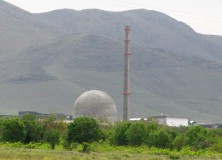Countering Iran’s Nuclear Ambitions, 2002-2008 — Jamie Boulding

INTRODUCTION:
In 2003, the International Atomic Energy Agency (IAEA) discovered that Iran’s nuclear program was far more advanced than even U.S. intelligence had expected. Since then, a variety of diplomatic groups have sought Tehran’s assurance that Iranian nuclear research is peaceful in nature. The George W. Bush administration supported, but did not directly participate in, most of this diplomacy. Towards the end of the administration, U.S. engagement focused on containment of Iran and became more proactive. After January 2007, President Bush spearheaded three sanction-imposing resolutions in the United Nations Security Council. The administration also sought to increase its projection of military and intelligence power in the Persian Gulf. However, the Bush White House was unable to resolve the standoff, leaving the Obama administration to grapple with the specter of a nuclear armed Iran.
STRATEGY:
The Bush administration generally acted in an ad hoc manner in response to the Iranian nuclear issue. The While House reacted to developments in negotiations between the EU-3 (Great Britain, France, and Germany) and Iran, and failed to formulate a coherent, purposeful strategy. Senior administration officials concede that Iran policy was not formally established at the end of the first Bush term. In an implicit recognition of the inadequacy of existing national security structures, the administration established the Proliferation Security Initiative in 2003. The initiative was an ad hoc yet proactive global framework which sought to integrate counterproliferation resources. In March 2005, the administration publicly endorsed the EU-3 negotiations and in May 2006 U.S. officials offered to enter into talks on the basis of Iranian suspension of uranium enrichment. Iran rejected the deal. In January 2007, President Bush indicated that the administration would henceforth focus on containment, involving a military build-up in the region, increased military aid and intelligence sharing with Persian Gulf states, and further isolation of Iran in international financial markets. The president maintained that military options against Iran’s nuclear facilities would remain “on the table.”
INTEGRATED ELEMENTS OF NATIONAL POWER:
The literature analyzing the U.S. approach uniformly attests to the inadequacy and incoherence of the plans, processes, and organizations which sought to counter Iran’s nuclear ambitions, at least for the first five years of the Bush administration. The common narrative suggests that “hawkish” figures, particularly in the Office of the Secretary of Defense and on the vice president’s staff, promoted regime change in Iran, but were constrained by Iraq policy. More “liberal” elements of the administration, typically identified as State Department officials, pushed for stronger engagement in bilateral diplomacy on specific issues, such as security in Iraq and Afghanistan. After a protracted period of drift and disorganization, the administration mobilized various agencies, departments, foreign governments, and the Congress around a strategy of containment. This approach has been characterized by improved integration of national power and interagency cooperation.
EVALUATION:
Plagued by bureaucratic in-fighting, conflicting interagency cultures and ideologies, poor decision making mechanisms, and the absence of an overarching, coherent policy, the U.S. government surrendered the lead on Iran to the EU-3 for much of the Bush administration. Institution-specific values, particularly at the State Department, dominated policy making leading to incremental, ad hoc, and ineffective courses of action. The president’s inability or unwillingness to enforce consensus on national security policy and to dedicate sufficient attention, resources, and energy to the problem established an unhelpful and misleading disconnect between the content of American rhetoric and the substance of U.S. policies.
RESULTS:
Failing to pursue a unified and disciplined approach, the U.S. government allowed Iran additional time to develop its nuclear program and damaged relations with U.S. allies. Contradictory gestures such as conferring legitimacy on Iran by offering to enter into negotiations while also hinting at regime change, undermined U.S. credibility and leverage. Nevertheless, at the end of the Bush administration, international diplomatic and financial pressure made some progress in constraining Iran’s nuclear capacity.
CONCLUSION:
The realization of Tehran’s nuclear ambitions would advance Iran’s expansionist regional ambitions, constitute an existential threat to Israel, and threaten U.S. forces and allies in the region. Possession of a nuclear capability would strengthen the existing regime and reduce the prospect of democratic reform. An Iranian atomic bomb would also increase the likelihood of nuclear material falling into the hands of terrorist groups and possibly trigger a nuclear arms race in an already volatile region. Iran’s willingness to conceal the extent of its nuclear program, combined with its resistance to conventional forms of diplomatic pressure, indicates that successful resolution of the Iranian nuclear problem without premature use of military force by the United States and international community will likely require the use of a wide and integrated set of national and international security tools.